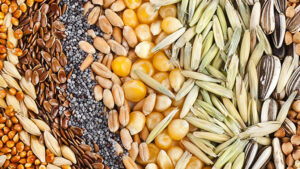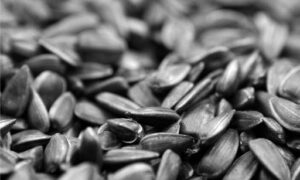
Ukraine will be able to export 50 million tons of grains and oilseeds from the 2023 harvest, as well as about 10 million tons of vegetable oils and meals to global markets, said Mykola Gorbachev, president of the Ukrainian Grain Association.
“We planned to export about 5 million tons per month. However, in the first four months (the grain marketing year starts in July – IF-U) this did not happen. We were unable to increase shipments through the Danube ports, which accounted for 3.5-3.7 million tons per month. With the launch of the grain corridor, the ports of Greater Odesa have a lot of potential. It is possible to ship 3-4 million tons (of grains and oilseeds – IF-U) per month through the ports of Greater Odesa alone,” he said at the Business Breakfast with Forbes Ukraine on Wednesday.
In total, Ukraine will be able to export about 6 million tons of grain a month through the sea corridor and across its western borders, according to the UGA president’s estimates, which was already done in November.
“We will be able to work harder, increase (exports – IF-U) a little bit more, and I think it will be technically feasible to supply 50 million tons of grains and oilseeds to foreign markets,” Gorbachev said.
He added that Ukraine will produce another 10 million tons of agro-processed products, including vegetable oils and meals.
“We will sell most of the grain and manufactured products. For us, this is more than 50% of the country’s foreign exchange earnings, which stabilizes the hryvnia. I think the state has little choice: either the harvest will rot or it is better to sell it. Of course, it’s better to sell,” said the UGA president and expressed confidence that traders will cope with this task if the military ensures the safety of shipping at the current level.
Gorbachev emphasized that in 2023 Ukraine managed to maintain its status as the world’s breadbasket, as farmers grew 81 million tons of grains and oilseeds against domestic consumption of 23-24 million tons. He emphasized that Ukraine produces three to four times more crops and processed products than it consumes, so the agricultural sector is clearly export-oriented.

Agrarians of all regions of Ukraine have threshed 57.6 million tons of grain and oilseeds, including 39.228 million tons of cereals and 18.457 million tons of oilseeds, the press service of the Ministry of Agrarian Policy and Food reported. According to the message, harvesting of grain and leguminous crops was carried out on the area of 8275.3 thousand hectares with a yield of 47.4 c/ha.
To date, Ukraine has completed collection and threshing of barley from 1505 thousand hectares (101% of the plan), which received 5.863 million tons, wheat – from 4695 thousand hectares (101%) collected 22.210 million tons, peas – from 154.4 thousand hectares (103%) received 396.8 thousand tons, as well as rape – from 1396 thousand hectares (98%) received 4.005 million tons of seeds.
Harvesting of millet, which from 77.4 thousand hectares (93%) received 162.4 thousand tons, and buckwheat – from 136.6 thousand hectares (97%) threshed 203.6 thousand tons. Corn from 1376.7 thousand hectares (34%) was threshed 9.282 million tons
In addition, 961.6 thousand tons of other cereals and leguminous crops were threshed from 331.2 thousand hectares.
Ukraine continues harvesting oilseeds, in particular, sunflower – 10.211 million tons (9.042 million tons a week earlier) from the area of 4.358 million hectares (86%), soybeans – 4.2411 million tons (3.776 million tons) from 1.641 million hectares (91%).
Sugar beet was dug from the area of 125.3 thousand hectares (96.4 thousand hectares a week earlier), which amounted to 50% of the planned area. It was received 5.912 million tons.
In connection with the revision of the forecast, the Ministry of Agrarian Policy monitors information on yields of all crops. Thus, wheat yield amounted to 47.6 c/ha, barley – 39 c/ha, peas – 25.7 c/ha, millet – 21 c/ha, buckwheat – 14.9 c/ha. Corn yield – 67.4 c/ha, rapeseed – 28.7 c/ha, soybean – 25.8 c/ha, sunflower – 23.4 c/ha. Yield of sugar beet – 471.9 c/ha.
As reported, winter wheat sowing this season amounted to 4166 thousand hectares (-834 thousand hectares to the previous season), winter barley – 536 thousand hectares (-255 thousand hectares), rape – 1374 thousand hectares (+110 thousand hectares).
The Ministry of Agrarian Policy noted that agrarians of Kyiv, Kirovograd, Mykolayiv, Poltava, Sumy, Cherkasy and Khmelnytskyi regions threshed more than 2 million tons of grain in each region. In Odessa, Vinnitsa and Dnipropetrovsk regions – more than 3 million tons each. Zaporizhzhya region has completed harvesting of grain crops.
According to the adjusted forecast of the Ministry of Agrarian Policy, in 2023 agrarians will be able to harvest 79.1 million tons of grain and oilseeds, of which grain crops will be produced in the following volumes: wheat – 21.7 million tons, barley – 5.7 million tons and corn – 28.5 million tons. Gross production of oilseeds will reach 21.6 million tons, in particular, sunflower – 13 million tons, rapeseed – 4 million tons, soybeans – 4.6 million tons. The sugar beet harvest is forecasted at 13.7 million tons.
As reported, at the beginning of spring 2023, the total gross harvest for the current year was forecast at 63.5 million tons, or 13% less than in 2022. In June, after harvest began, the forecast was raised to 68 million tons, (7% less). In early September, due to favorable weather conditions, the forecast was revised upward to 76.7 million tons.

Kernel, one of the largest agricultural holdings in Ukraine, has almost completed harvesting winter wheat on an area of 60 thousand hectares and winter rapeseed on 10 thousand hectares, noting an increase in yields and forecasting an increase in production of all crops in the 2023 season, the company said in a statement on the Warsaw Stock Exchange.
According to the report, in the 2023 season, the agroholding expanded the area under winter wheat by 1.7 times, and winter rapeseed by twice compared to last year. Favorable weather conditions resulted in higher yields of these crops: winter wheat yields reached 6.6 t/ha, which is significantly higher than a year earlier, when it was 4.6 t/ha; winter rapeseed yields were 3.3 t/ha, compared to 2.5 t/ha a year earlier.
“Kernel has also allocated significant areas for spring crops, including 120 thou hectares of sunflower, 84 thou hectares of corn and 65 thou hectares of soybeans.
“Risks for the group’s spring crops (corn, sunflower and soybeans) are currently limited, so the group expects to get yields close to historical averages,” the agricultural holding said.
“Kernel assesses the harvest prospects in Ukraine as “generally favorable” and forecasts an increase in grain and oilseed production compared to the previous year.
Speaking about the prospects for sales of the grown products in FY2024, the baseline scenario of the agricultural holding envisages exports only through the Danube River ports and inland routes due to the susceptibility of agricultural infrastructure to destruction caused by Russia’s regular missile attacks.
“Kernel has already secured some capacity to export sunflower oil and meal, but has not yet secured a stable and cost-effective grain transshipment option. The agroholding announced the need for additional investments to increase grain export capacity and reduce logistics costs.
“At the beginning of the season, the profit forecast for FY2024 envisages a significant decrease in EBITDA due to the undermined productivity of the agriculture, infrastructure and trade segments, which is caused by relatively weak global grain prices and expensive export logistics,” the agricultural holding explained.
At the same time, Kernel expects the oilseeds processing segment to be the main source of profit for the group in fiscal 2024.
The agroholding reported that it does not have access to credit limits from banks and relies on accumulated cash. At the same time, it continues negotiations with various financial institutions to obtain CapEx loans.
Uncertainty over VAT refunds in the future and the possible risk of hryvnia devaluation also increase the agroholding’s exposure to foreign exchange losses.
“Any estimates of volumes and margins are very sensitive to the current operational situation in Ukraine due to the constant disruptions caused by the war. The holding’s work is aimed at reducing further risks of losses caused by possible future Russian attacks,” Kernel summarized.
Before the war, Kernel was the world’s leading producer of sunflower oil (about 7% of global production) and its exports (about 12%). The company is one of the largest producers and sellers of bottled oil in Ukraine. In addition, the agricultural holding is engaged in the cultivation and sale of agricultural products.
The largest co-owner of Kernel through Namsen Ltd. is Ukrainian businessman Andriy Verevsky, who this year increased his stake from 41.3% to 74.05% as part of the buyout and delisting of the company from the Warsaw Stock Exchange.
Kernel’s net profit for the first nine months of FY2023 (July 2022 – March 2023) increased by 36% to $437 million, while revenue fell by 45% to $2.715 billion.

Harvest of seeds of the main types of oilseeds in Ukraine in 2023/24 MY will grow to 19.5 million tons, which is 7.7% higher than in the previous season, predicted the association “Ukroliaprom”.
The industry association recalled that by exporting sunflower seeds from Ukraine sufficient to meet the needs of the EU and other countries in volumes, the country loses the market for sunflower oil and meal in these countries.
“The mass export of oilseeds from Ukraine to the world market has led to a sharp drop in prices, which has caused discontent among farmers in European countries. As a consequence, the mass export of sunflower seeds from Ukraine has led on the part of some EU countries to a ban on imports into their territory until mid-September 2023, and possibly until 2024”, – noted in “Ukroliaprom”.
The association expressed confidence that this would not have happened if the repeated requests of Ukroliaprom to limit sunflower seed exports, particularly to EU countries, by introducing additional fees and licensing had been taken into account.
Ukroliaprom expects soybean exports from Ukraine to exceed 3.0 million tons at the end of MY 2022/23, or more than triple against MY 2021/22.
“This may negatively affect domestic processing, which even under martial law remained not only stable, but also increased,” experts emphasized.
The industry association expects the highest production growth in MY 2023/24 for soybeans – by 12.2% to 4.107 million tons. This will happen thanks to a 20.5% increase in sown areas, which reached 1.84 million hectares, but the yield of the oilseed crop will increase by only 0.4% to 22.3 c/ha.
Sunflower production this season will increase by 6.5% year-on-year to 11.813 million tons. Despite the expansion of areas under the crop by 7.7% to 5.64 million hectares, analysts expect yields to be 3.3% lower than last year’s -20.9 c/ha.
Ukrpoliyaprom expects a 9.1% increase in the gross rapeseed harvest, which will amount to 3.318 million tons. It will be harvested from almost 1.35 million hectares (+16.3%) at a yield of 26.5 c/ha (-9.3%).
“At the same time, we should take into account significantly lower carryover residues of oilseeds in Ukraine at the beginning of MY 2023/24 against the beginning of the previous season. Accordingly, the supply in 2023/24 MY will be less, which requires urgent action at the government level to create conditions for maximum domestic processing and increase exports of products with high added value,” – summarized in the industry association.

According to the results of the spring sowing season 2023 in Ukraine, farmers increased the areas under grain crops, particularly corn, and reduced the areas under oilseeds, particularly sunflower, and will get 61.4 million tons of gross crop of these crops, according to the website of the Ukrainian Club of Agrarian Business (UCAB) on Tuesday.
It is specified that such changes are fixed compared to the previous UCAB forecast, but not to the previous year. The forecast also raised yield expectations for winter crops.
UCAB estimates that the 2023 crop area will be 10.1 million hectares (4.4 million hectares of wheat, 3.8 million hectares of corn and 1.4 million hectares of barley). As a result, it is expected to harvest 42.5 million tons of cereals, of which 16.3 million tons of wheat, 21.1 million tons of corn and 4.2 million tons of barley.
Experts estimate the area under oilseeds at 8.9 million hectares, including 5.7 million hectares of sunflower, 2 million hectares of soybeans and 1.2 million hectares of rape. It is noted that Ukraine can expect to get the gross yield of oilseeds at 18.9 million tons, including 12.2 million tons of sunflower, 3.8 million tons of soybeans and 2.9 million tons of rapeseed.
“According to preliminary estimates, this harvest will fully meet domestic demand and get the export potential at 43 million tons of grains and oilseeds,” forecasts UCAB.
Analysts attributed the lion’s share of last year’s corn harvest, which was in high demand, to the positive factors of the current season. The expansion of area under this crop will contribute to the world tendency to reduce prices for fertilizers, which will be felt in Ukraine as well and this will provide maize with their sufficient quantity.
They advised to remember that the introduction of corn production has certain technological difficulties for farmers: the current high saturation with oil-bearing crops, the possible further disease pressure, increased load on combines because of the overlap of harvest periods of other crops, the lack of quality seeds of other crops, etc.
The UCAB also pointed out that since the beginning of the war, the main consumers of oilseeds were EU countries, primarily neighboring countries. However, because of the temporary restrictions on imports of some grains by them, further increase of areas sown with oil-bearing crops looks risky.
According to analysts, Ukraine managed to survive the Russian energy terror and adapt to the new realities, gives hope to the ability of farmers to withstand a possible repetition of the situation.

TAS Agro agrarian group will reduce sowing areas of oilseeds, expand the grain group and start growing sugar beet in season 2023, the company’s press service said.
“Despite the late start of the sowing season caused by weather conditions, all works will be performed in optimal agronomic terms. Modern technological complexes, which increase the accuracy of seeding and increase the productivity of works, are involved in the sowing campaign”, – stated in the press release.
It is specified that the spring sowing campaign in Kirovograd region started with sunflower sowing.
“TAS Agro” is planning to sow 23.3 thousand hectares of corn, 16.1 thousand hectares of sunflower and 11.5 thousand hectares of soybeans in 2023. “Compared to the last year we are going to reduce the area of oil crops and increase the area of grain group. Sowing area in the company as a whole has not changed, but because of food security and market situation this season sugar beet was added to the structure of crops”, – stressed the press service.
After the end of the sowing season the holding will make additional application of nitrogen fertilizers. The company intends to change the technology of plant nutrition, for which the yield of crops in each field over the past five years has been analyzed. According to the data received, the fields were divided into categories, according to which the yield and nutrition system will be planned. “We will be able to not just save money, but increase the efficiency of the money invested in fertilizers,” the company notes.
Before the war TAS Agro worked 83 thousand hectares in Vinnitsa, Kiev, Kirovograd, Chernigov, Nikolaev, Sumy, Kherson and Dnipropetrovsk regions, was engaged in dairy farming (up to 5.5 thousand cattle), owned six elevators with simultaneous storage capacity of 250 tons.
TAS Group was founded in 1998. The sphere of its business interests covers the financial sector (banking and insurance segments) and pharmacy, as well as industry, real estate, venture projects.
The founder of TAS is Sergiy Tigipko.